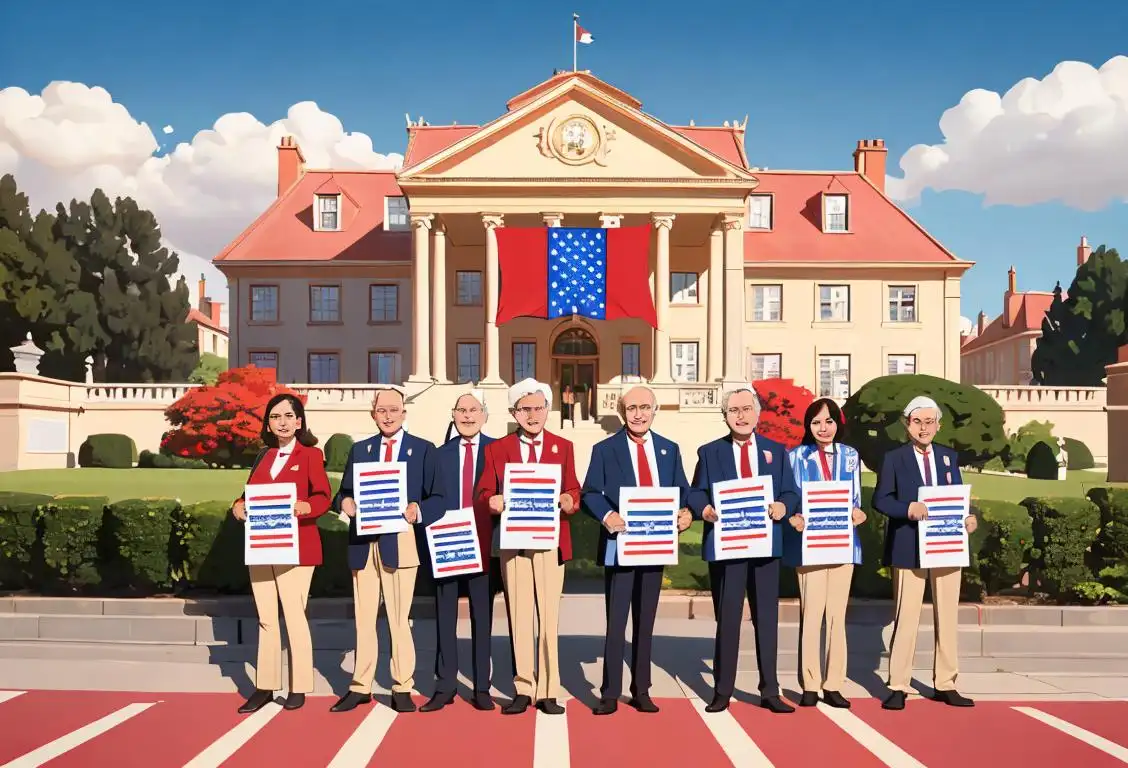National Pow Mia Recognition Day

Ah, National POW/MIA Recognition Day, a day to remember and honor the brave men and women who have served our country and never returned home. Let's dive into the intriguing history behind this important day!
When is Pow Mia Recognition Day?
It's national pow mia recognition day on the 21st September.
The Origin of National POW/MIA Recognition Day
Every year on the third Friday of September, National POW/MIA Recognition Day is observed to pay tribute to the thousands of American servicemen and servicewomen who are either prisoners of war (POW) or missing in action (MIA).
The history of National POW/MIA Recognition Day dates back to the 1970s, during the Vietnam War. As the war drew to a close, concern grew for the American POWs who were still being held captive. Families and advocates tirelessly fought to bring attention to their plight.
Finally, in 1979, a resolution was passed by Congress designating the third Friday of September as National POW/MIA Recognition Day. Since then, it has become an annual observance dedicated to remembering and raising awareness about POWs and MIAs from all conflicts.
How National POW/MIA Recognition Day is Celebrated
On this day, various events and ceremonies are held across the country to honor those who have made tremendous sacrifices for our freedom. The National League of Families of American Prisoners and Missing in Southeast Asia spearheads many of these activities. They encourage individuals, communities, and organizations to participate by flying the POW/MIA flag, holding candlelight vigils, organizing memorial services, and more.
History behind the term 'Pow Mia Recognition'
1970
Formation of the POW/MIA Bracelet Campaign
The term 'POW/MIA recognition' originated with the formation of the POW/MIA Bracelet Campaign in 1970. During the Vietnam War, concerned citizens and organizations started producing metal bracelets engraved with the names of American prisoners of war (POWs) and those missing in action (MIA). People wore these bracelets as a way to raise awareness and show support for soldiers who were held captive or unaccounted for.
1979
Origin of the POW/MIA Recognition
The term 'POW/MIA Recognition' originated in 1979 as a way to acknowledge and raise awareness about prisoners of war (POW) and those missing in action (MIA) from past military conflicts. This movement was primarily driven by the families of these servicemen and women who sought answers and closure regarding the fate of their loved ones.
1967
Introduction of the POW/MIA flag
In 1967, the POW/MIA (Prisoner of War/Missing in Action) flag was introduced by Mary Hoff, the wife of a missing service member. Mary, along with other wives of POWs and MIAs, created the flag as a symbol of recognition and remembrance for those who were captured or went missing during the Vietnam War. The flag features a silhouette of a prisoner of war against a black background, with the words 'POW/MIA You Are Not Forgotten' written in white.
1966
Origin of POW/MIA Recognition
In 1966, during the Vietnam War, the phrase 'POW/MIA recognition' first came into prominence. This term stands for Prisoners of War (POW) and Missing in Action (MIA). As the war raged on, the conditions and treatment of captured soldiers became a growing concern. The POW/MIA recognition term emerged as a way to acknowledge and honor those servicemen and women who were either held captive or went missing during the conflict.
1970
Vietnam War and Missing in Action (MIA)
The term 'POW/MIA recognition' originated during the Vietnam War when thousands of American servicemen were captured as prisoners of war (POWs) by the North Vietnamese forces. The MIA acronym, which stands for Missing in Action, refers to the soldiers who were lost and presumed dead but whose remains were not recovered. The U.S. government made efforts to account for these servicemen and establish their status following the conflict.
1970
The term 'POW/MIA' is coined
In 1970, during the height of the Vietnam War, the term 'POW/MIA' (Prisoner of War/Missing in Action) was officially coined. This term was used to refer to the servicemen and women who were either held as prisoners of war or considered missing while serving in the Vietnam War. The POW/MIA recognition movement gained momentum as families and friends of the missing soldiers sought answers and closure.
1979
Formation of POW/MIA Recognition Day
In 1979, the United States Congress designated the third Friday in September as National POW/MIA Recognition Day. This day was established to honor and remember the sacrifices and courage of prisoners of war (POWs) and those who are missing in action (MIA). The aim was to bring national attention to their plight and to ensure that they are never forgotten.
Vietnam War era (1963–1975)
The Origin
The term 'POW/MIA recognition' originated during the Vietnam War era. It is an acronym that stands for Prisoner of War/Missing in Action recognition. This term emerged as a result of the large number of servicemen who were captured as prisoners of war or went missing during the conflict.
1979
The beginning of the awareness
The term 'POW/MIA recognition' originated in 1979 when the United States Congress designated the third Friday in September of each year as National POW/MIA Recognition Day. This day was established to honor and remember the service members who were prisoners of war (POW) or missing in action (MIA). It aims to raise public awareness about the sacrifices made by these courageous individuals and to promote efforts to account for those who remain missing.
1979
Establishing POW/MIA Recognition Day
In 1979, Congress passed a resolution designating the third Friday in September as National POW/MIA Recognition Day. This day was established to honor the sacrifices and service of military personnel who were prisoners of war or still missing. It aimed to raise awareness about the plight of POWs and MIAs and to remind the public to recognize their sacrifice and continue efforts to locate and bring them home.
1971
Creation of the POW/MIA Flag
In 1971, the National League of Families of American Prisoners and Missing in Southeast Asia designed the iconic POW/MIA flag. The flag features a silhouette of a man, a watchtower with a guard, and a strand of barbed wire against a black background. This powerful symbol represented the plight of missing and captured servicemen and became a symbol of hope and remembrance.
1984
Creation of the POW/MIA Recognition Day
In 1984, the United States Congress designated the third Friday of September as the official POW/MIA Recognition Day. This day serves as a national observance to honor the sacrifices of POWs and MIAs, their families, and to reaffirm the commitment to account for those still missing.
1971
Congressional Resolution for the 'POW/MIA' Flag
In 1971, the United States Congress passed a resolution authorizing the creation of the POW/MIA flag. The black flag, featuring a silhouette of a man beneath a guard tower, a strand of barbed wire, and the words 'POW' and 'MIA,' symbolizes the nation's commitment to remember and honor the sacrifices made by prisoners of war and those missing in action. This official recognition further popularized the term 'POW/MIA recognition' within the American consciousness.
1979
National POW/MIA Recognition Day
In 1979, the United States observed the first National POW/MIA Recognition Day. This day is designated to honor and remember the sacrifices of prisoners of war and those who are still missing in action. The day is officially recognized on the third Friday of September each year. It is a time for the nation to come together and pay tribute to the men and women who have suffered captivity or are still unaccounted for.
1984
The POW/MIA Flag becomes an Official Symbol
In 1984, the POW/MIA Flag, featuring a silhouette of a soldier against a black background with the words 'POW MIA' in white, was officially recognized as a symbol of POW/MIA remembrance. The flag was designed by Newt Heisley in 1971 and quickly gained widespread popularity. It became a powerful symbol of solidarity and a constant reminder of the servicemen who were either prisoners of war or missing in action.
1970
Formation of the National League of Families
In 1970, the National League of Families was established with the goal of seeking answers and advocating for the release of POWs and accounting for those missing in action. This organization played a crucial role in raising awareness about the POW/MIA issue and pushing for recognition in the United States. Their efforts led to the introduction of special national days dedicated to honoring and remembering POWs and MIAs.
1972
POW/MIA flag is created
In 1972, the POW/MIA flag was designed by Newt Heisley, an Air Force pilot and advertising executive. The flag features a black silhouette of a man's head and a watchtower against a white circle, above which is a white five-pointed star on a black field. The flag became a potent symbol of the movement and a powerful reminder of the ongoing search for missing soldiers.
1982
Formation of the National League of Families
In 1982, the National League of Families of American Prisoners and Missing in Southeast Asia, also known as the National League of Families, was instrumental in the creation of the POW/MIA flag. This flag, with its distinctive black and white design, was officially recognized by Congress as the symbol to represent POW/MIA recognition. It serves as a potent symbol of the nation's commitment to never forget the brave men and women who were captured and the ones who remain missing.
1990
POW/MIA flag becomes an official symbol
In 1990, the United States Congress passed a law declaring the POW/MIA flag as an official symbol of the United States. This recognition solidified the importance of the flag and its significance in honoring prisoners of war and missing service members. The flag is now flown at various government buildings, military installations, and public locations across the country.
1982
National POW/MIA Recognition Day
In 1982, the United States declared the third Friday in September as National POW/MIA Recognition Day. This annual observance aims to pay tribute to the POWs and MIAs, raise awareness about their fate, and show support for their families. The term 'POW/MIA recognition' took on additional significance as the nation united in honoring and remembering those who served and were still unaccounted for.
1979
National POW/MIA Recognition Day is established
On July 18, 1979, the United States Congress designated the third Friday of September as National POW/MIA Recognition Day. This day was established to honor and remember the sacrifices of prisoners of war and those who are still missing in action. It serves as an opportunity for the nation to express gratitude to the servicemen and women who endured captivity and to renew the commitment to locate and repatriate those who remain missing.
1984
The POW/MIA Flag
The iconic black and white POW/MIA flag was created in 1984 by the National League of Families of American Prisoners and Missing in Southeast Asia. This flag features a silhouette of a man's head with a barbed wire fence and a watchtower in the background, symbolizing captivity. It gained widespread recognition as a symbol of POW/MIA recognition and advocacy.
1979
POW/MIA Recognition Day
In 1979, the United States Congress passed a resolution designating the third Friday in September as National POW/MIA Recognition Day. This day serves as a reminder to honor and remember those who served their country and were never returned home. It is a day of reflection, gratitude, and hope for the safe return of all missing servicemen.
1986
The National League of Families' POW/MIA Flag
The National League of Families, an organization composed of relatives of POWs and MIAs, designed the iconic POW/MIA Flag. Created in 1971, it gained widespread recognition in 1986 when it was officially recognized by the U.S. Congress. The flag consists of a silhouette of a POW against a black background, with the words 'You Are Not Forgotten' written above and 'POW/MIA' below.
1998
Moving the observance to a specific day
In 1998, President Bill Clinton signed a law that modified the observance of National POW/MIA Recognition Day. The third Friday of September was designated as the specific day to honor and remember the American prisoners of war and those missing in action. This move aimed to provide a nationally recognized day and ensure a consistent annual commemoration.
1998
The Return of the Hanoi Hilton Artifact
In 1998, as a significant step in the recognition of POWs and MIAs, the Hanoi Hilton artifact was returned to the United States. The Hanoi Hilton was a prison where American prisoners of war were held during the Vietnam War. The return of the artifact symbolized a gesture of reconciliation and acknowledgment of the past, serving as a reminder of the sacrifices made during the war.
1979
First National POW/MIA Recognition Day
The first National POW/MIA Recognition Day was observed on July 18, 1979. This day was designated to raise public awareness about the plight of POWs and MIAs and to honor their sacrifice. It was a significant step towards acknowledging the sacrifices made by those who were captured or went missing while serving the country.
1998
POW/MIA Recognition Day made law
In 1998, President Bill Clinton signed a law making National POW/MIA Recognition Day an official observance. This law ensures that the day is nationally recognized and observed annually. The day serves as a reminder to never forget the sacrifices made by those who have served our nation and were taken captive or remain missing.
1982
Return of the Remains of Vietnam War POWs
In 1982, following the Vietnam War, the United States received the remains of the first Prisoners of War from Vietnam. The return of these remains marked an important step in the ongoing effort to account for all missing service members who made the ultimate sacrifice. It reinforced the significance of the POW/MIA recognition movement and provided closure to some families.
1984
The POW/MIA Flag becomes an Official Symbol
In 1984, the POW/MIA Flag, with its distinctive black and white design featuring a silhouette of a man beneath a guard tower, became an official symbol of the United States. The flag serves as a powerful reminder of the ongoing commitment to never forget those who were prisoners of war or still missing in action. It is often flown alongside the American flag on designated days, including National POW/MIA Recognition Day.
2000
The National POW/MIA Recognition Day
Since the year 2000, National POW/MIA Recognition Day has been observed on the third Friday of September. On this day, ceremonies and events are organized nationwide to pay tribute to the sacrifices made by former prisoners of war and missing service members. It serves as a reminder to the public to support efforts to achieve the fullest possible accounting of those still missing, and to support the families who continue to seek answers and closure.
1998
Pow Mia Recognition Act
In 1998, President Bill Clinton signed the POW/MIA Recognition Act into law. This act reaffirmed the commitment of the United States government to account for and bring home all Americans who were prisoners of war or missing in action. It solidified the importance of POW/MIA recognition and ensured continued efforts to locate and identify missing servicemen.
2010
The POW/MIA Chair of Honor
In 2010, the concept of the POW/MIA Chair of Honor was introduced. These chairs are typically placed in prominent locations such as stadiums, concert venues, and government buildings as a tribute to prisoners of war and those missing in action. The empty chair signifies their absence and serves as a solemn reminder of their sacrifice and the ongoing commitment to bring them home.
1990
POW/MIA flag becomes an officially recognized symbol
In 1990, the National League of Families of American Prisoners and Missing in Southeast Asia successfully advocated for legislation that officially recognized the POW/MIA flag as the symbol of America's concern and commitment to resolving the fate of the missing servicemen. This recognition solidified the significance of the flag as a national symbol and a constant reminder of the unresolved issues surrounding prisoners of war and missing service members.
1998
Installation of POW/MIA Chairs
As part of the ongoing efforts to honor and remember POWs and MIAs, the concept of installing empty chairs in public spaces began. The chairs symbolize the missing individuals and serve as a reminder of their sacrifice. The first known installation of a POW/MIA Chair was at Veterans Memorial Coliseum in Portland, Oregon, in 1998.
2000
POW/MIA Recognition Day Becomes Law
In the year 2000, the POW/MIA Recognition Day was officially made into law by President Bill Clinton. This legislation reaffirmed the significance of the day and ensured its continued observance in the future, helping to maintain awareness and remembrance of POWs and MIAs.
1991
POW/MIA Flag Displayed Permanently
In 1991, the POW/MIA flag was permanently displayed in the Capitol Rotunda of the United States Capitol Building. This act solidified the national recognition of POWs and MIAs and further elevated the importance of honoring and remembering their sacrifice. The flag continues to fly perpetually, ensuring a constant reminder of the commitment to bring all missing servicemen home.
2014
Recognition of National POW/MIA Recognition Day by the President
In 2014, President Barack Obama emphasized the significance of National POW/MIA Recognition Day by issuing a proclamation to honor and remember the brave individuals who have been prisoners of war or are still missing in action. This recognition from the president further solidified the importance of the day and its impact on raising awareness and support for POW/MIAs.
1998
The return of remains from North Korea
In 1998, North Korea turned over remains believed to be those of American servicemen who fought in the Korean War. This event was a significant step in the ongoing efforts to account for missing soldiers and bring closure to their families. It highlighted the international cooperation required to resolve the POW/MIA issue and marked a significant turning point in the search for answers.
2008
National POW/MIA Recognition Day Observance
Since the establishment of POW/MIA Recognition Day in 1979, it has been observed every year on the third Friday in September. The observance includes various ceremonies, tributes, and events to honor the sacrifices of POWs and MIAs in all conflicts and to show support for their families. It serves as a reminder to the nation to never forget the service and sacrifice of these brave men and women.
1998
Change from a Single Day to a Week of Recognition
In 1998, the observance of National POW/MIA Recognition Day expanded to an entire week, known as National POW/MIA Recognition Week. This change allowed for more extensive commemoration and activities to honor and support POWs and MIAs. Throughout the week, various events, ceremonies, and gatherings take place across the country to express gratitude and keep the issue in the public consciousness.
1998
POW/MIA Interment Flag Designated
In 1998, Congress enacted legislation that authorized the provision of a burial flag to honor the memory of military personnel who were accounted for but whose remains were unidentifiable or unidentifiable as individuals. The specially designed flag, known as the POW/MIA interment flag, preserves the memory of all servicemen and serves as a symbol of reverence during their final resting place.
2014
Renaming of Veteran's Day to Honor POW/MIA Service Members
In 2014, President Barack Obama signed into law the 'National POW/MIA Remembrance Act of 2013,' which renamed the federal holiday celebrated on November 11th from 'Veteran's Day' to 'Veterans Day' to officially recognize and honor the service of all veterans, including POWs and MIAs. This change highlighted the enduring effort to remember and support those who have suffered as prisoners of war or remain missing while serving in the United States Armed Forces.
Did you know?
Did you know? The iconic POW/MIA flag, featuring a silhouette of a bent silver bracelet superimposed on a black field, was first designed in 1971 by the wife of a POW named Mary Hoff. Today, it serves as a powerful symbol of remembrance and hope for the safe return of our missing servicemen and servicewomen.Tagged
awareness rememberanceFirst identified
18th September 2015Most mentioned on
21st September 2018Total mentions
37Other days
Voters Day
Unemployed Day
Suicide Prevention Day
Cancer Survivors Day
Memorial Day
Bestfriends Day
Heroes Day
Liberation Day
Pumpkin Day
Gymnastics Day









